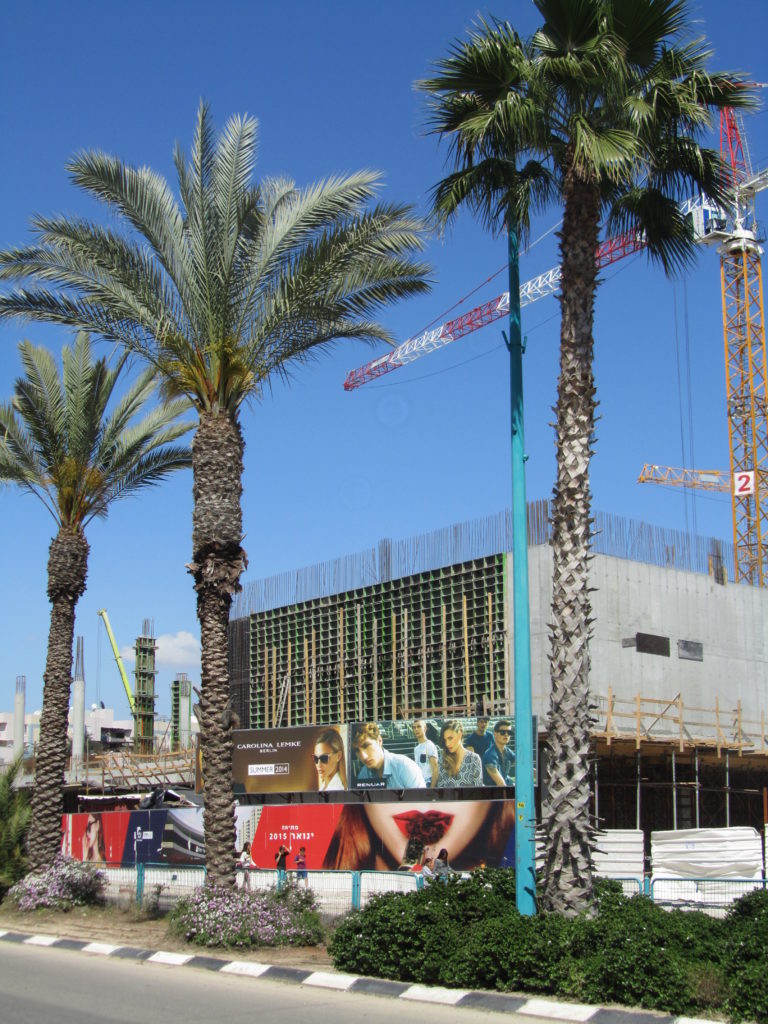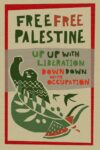During my first week in Israel, I was set up with a family in Petah Tikvah, a medium-sized city about ten miles east of Tel Aviv, for the Rosh Hashanah holiday. My host, Golan, picked me up in Ramle, about thirteen miles southeast of Tel Aviv, where I was to live for the next eight months.
Ramble — a corruption of the Arabic word ramal, or sand dunes — looks and feels like a desert town that unexpectedly became a testament to humanity’s determination to subdue its surroundings. Rows of hastily-built, dreary apartment blocks, all painted the same unremarkable shade of tan, squat along the city’s streets like weary travelers that have sat down and decided to die.
Like the entire country, Ramle both is and isn’t a very diverse place. There are Jews — from Ethiopia, from the former Soviet Union, from India, from South America, from Central Asia, from all over the Middle East and North Africa; secular and religious; kippehs and counterfeit designer clothes; old and weary; young and brash — 80 percent of the population. And there are Arabs, Muslim and Christian Palestinian citizens of Israel; resettled Bedouins and deeply-rooted families; head scarves and dark flowing hair; fluently flipping between tongues and dispositions — 20 percent of the population. There are smatterings of Sudanese refugees and foreign workers, mostly from Thailand and the Philippines. And yet despite this, you feel it is all flattened, sealed up behind the indiscriminate heat, the barely discriminate poverty, and the ceaseless monotony of the buildings, whose generic uniformity must mirror the sand dunes that once stood in their place. There are few outward displays of diversity; there are not many restaurants, there are not many places to shop, and it takes an insider’s eye to identify its various strains, found in side-alleys, unmarked stores, and cluttered stands in the city’s shuk.
Years of economic decline and crime have given Ramle a widespread (and inaccurate) reputation of danger and disrepute. Fifty years ago it was a popular nightlife destination — a fact that is astounding if you have been there recently — when I lived there, in 2013, there was not a single bar or cafe serving a city of seventy thousand. But in the past few years, as housing prices have skyrocketed across Israel, families are increasingly priced out of Tel Aviv and its immediate suburbs, and Ramle has found itself drawn deeper into the Gush Dan metropolitan area (the name for Tel Aviv and its surrounding cities). To accommodate and entice these newcomers, a rash of new, modern apartment buildings, generic in a different way, have sprouted across the city, including an entirely new neighborhood on its southern edge, dotting the skyline with cranes and construction crews. The focal point of this building boom, or perhaps its culmination, is a massive construction site. Not much more than a giant hole when I first arrived, it is located in the city’s center, a short walk from the reigning tourist attraction, the ruins of the White Mosque, built by Sulayman bin Abd al-Malik in 715. This pit would one day hold the city’s mall, which opened in February 2015.
Golan immediately apologized for his English, which ended up being unnecessary. He had an easy manner, frequently making himself laugh, only turning somber in matters of faith and fatherhood; he had recently become religious, although he didn’t wear a kippeh. His newfound devotion to the old faith, however, was infused with Western, post-religion dictates about the power of the mind and positive thinking. He asked if I would like to join him for Ma’ariv services to open Rosh Hashanah. I responded that I would.
It was my first time in a non-Ashkenazi synagogue. Golan told me the synagogue primarily serves the Iraqi community, although he is Yemeni (his wife’s family is Iraqi). The first difference I noticed was the layout. The bima, the stage from which the rabbi leads the services, sat at the center of the room and the seating was arrayed around it (women were seated upstairs, out of sight). Not all seats faced the rabbi, however; the first row faced the bima, but the next row, back-to-back, faced the outer walls and the third row, and so on. Nor were all the seats angled toward the stage, so even if you are sitting in a row nominally facing the stage you may actually be looking at your neighbor across from you the entire service, in contrast to an Ashkenazi synagogue, where the bima is usually at the front, or, at the very least, is the focal point of the room.
I wondered if this arrangement engendered a different sense of priority and community. In a synagogue like this, where the community is forced to look back upon itself — the men, at least — could you be forgiven for finding the meaning of it all, the foundation of this assembly, in the generosity of your neighbor’s eyes?
After the service ended, we wished everyone within arm’s reach “l’shana tova,” and continued on to the apartment of his wife’s parents for dinner. Waiting for us was Golan’s wife Nofar, her parents, Aaron and Rivka, and her sister, Etad. Nofar’s family spoke varying levels of basic English, and given that I could only say “hello,” “nice to meet you,” “everything is good,” and “you are a whore” in Hebrew, a lot of gesture, exaggerated expression, and careful enunciation were required of me..
We sat down for dinner, a meal I will never forget, not for any singular taste or exacting technique, although everything was delicious and well-prepared, but for the torrent of new flavors and sensations, one of those moments that extends the spectrum of experience and shakes the foundations of your self-assured cosmopolitanism.
My contribution to the dinnertime conversation, which moved at a dizzying pace, was minimal. Someone would ask me if I liked the food. Yes, very much, I would reply, nodding a few times and pantomiming a face of dreamy satiation. Everyone smiled and nodded. Rivka, the acknowledged matron of this gathering, kept insistently shoveling more food on to my plate and, lacking the linguistic skills to politely turn her down, I always acquiesced. Eventually I ate so much that I almost fell asleep at the table, head in my hands.
The next morning we returned for, inconceivably, another large meal. Then they decided to take me out, to show me around. Our destination was Herzliya, a wealthy beach community north of Tel Aviv. But we weren’t there to take a dip in the Mediterranean or to feel the sand bunch between our toes; we were not there to admire the yachts or to dream of their interior lives. We were there to go to the mall.
We walked down a passageway between the boats and a row of restaurants, and entered a world that was virtually indistinguishable from its American counterparts: multi-storied, brightly-lit, oozing an arctic tundra of air conditioning from unseen pores, perfumes enticingly wafting from open-door oracles to the ever-confounding enigma of next season, stores bearing a familiar, supranational aesthetic, cellphone stands clotting up busy causeways between them. Everything aspired to that same ethereal timelessness, a fantasy of pure transaction. Families perambulated without fixed purpose, groups of teenagers watched one another with curiosity, and shoppers enthusiastically gripped collated, multicolored bags under an approximation of daylight emanating from ovoid fixtures across the atrium. If I squinted my eyes and suppressed the sounds of language, subduing it to a muddy static, I could’ve been in any suburb in America.
I spent a lot of time in malls as a teenager, wandering around, watching my peers with barely suppressed awe, eating free samples in the food court (teriyaki chicken stabbed with a segment of raw noodle, usually), and frequenting favored stores with studied nonchalance, dreaming of how a few coveted purchases could alter my life and so simply ameliorate the anxieties of that age. I worked in the stock room of a Pottery Barn when I was nineteen. Even after I had stopped frequenting the stores, I went to the mall to see blockbusters. But all that feels like a different life. I can’t even remember the last time I was in a mall.
After walking around for thirty, forty-five minutes, we retired to one of the many restaurants residing in and around the mall. It was an Asian restaurant. Not Chinese or Japanese or Vietnamese, but generically East Asian – or, more accurately, a manifestation of what, in Israel, is collectively perceived to be East Asian, denuded of any specific cultural context, since there is essentially no organic East Asian culture within Israel. (Which isn’t to say there is no audience for it; sushi is phenomenally popular.) There were Buddhas, tigers, and, mysteriously, quotes from Sex Pistols, the Doors, and Nirvana lining the walls. You could order dim sum, which has simply become the word for steamed dumplings in Hebrew, or Pad Thai, or shakshuka. We ate, talked, paid and left.
A few days later, I went to karaoke night at Golan’s in-laws’ apartment. After this, I did not see Golan and his wife’s family again.
But the longer I was in Israel, the more I noticed malls creeping in on my consciousness. The central bus station in Jerusalem is in a mall, and next to the old city, one of the most important spiritual centers in the world and Israel’s biggest tourist attraction, is another, encased in the city’s famous limestone. Even in Tel Aviv — which has no shortage of interesting, independent shops — the enormous Dizengoff Center straddles two sides of an important commercial district and is always crowded. People asked if I had been to this mall or that mall; children in Ramle would ask if I had been to the mall in Rehovot, the next town over, their faces barely concealing a hope that I respond in the affirmative.
A few months later, I traveled to Istanbul. The first advertisement I saw in the airport was for a Ramada, trumpeting its central location “minutes away from the biggest shopping malls in Istanbul.” At dinner a few nights later, I happened to sit next to a number of American expatriates. The Americans had two friends in town visiting. They were sarcastically telling them about all the malls they could visit. The Gezi Park protests, which took place less than a year before my trip, started in response to a redevelopment plan, which would have built, among other things, a shopping mall. A song released at the time included the line, “They knocked down, / closed down cinemas and squares/ Covered in shopping malls / I don’t feel like crossing this bridge / What happened to our city?”
The phenomenon isn’t unique to the eastern Mediterranean. In Manila, malls have effectively subsumed the street life of the city; the Manila metropolitan area has more than one hundred malls, including sixteen supermalls. As Siddhartha Deb details in his book The Beautiful and the Damned, the hottest restaurant among Delhi’s moneyed classes a few years ago was Set’z, a multi-cuisine restaurant — that’s an established category in India — located in the DLF Emporio mall. The DLF Emporio is a luxury mall, with brands like Christian Louboutin, Dior, and Louis Vuitton. It is located right next to the DLF Promenade, another mall owned by the same developer that caters to middle-class consumers. Just up the street is a third mall from a different developer, the Ambience Mall. Of the hundred largest malls in the world, the majority were built within the last fifteen years and only eleven are located in the US.
Part of what’s so odd about these instances, at least as I perceived them, is the mall’s proximity to what I tend to think of reflexively as “real culture.” Golan and family offered me a rich cultural experience, allowing me to peek into the intimacy of their domestic and religious life. Tourists visit Istanbul to go to the Hagia Sofia and the Blue Mosque, to browse the Spice Market and the Grand Bazaar, not to go shopping in its malls; they visit Jerusalem to touch the Western Wall or walk along Via Dolorosa, not buy khakis at the Gap. Like many people I know, I think of myself as a good traveler; as opposed to a bad traveler, the kind who takes cruises or eats at the Applebee’s in Times Square.
So why take a foreign traveler to a mall at all? The way I see it, the mall trip is meant to communicate a message about the local culture — who they are, their country, their standard of living. They are taking me to the mall because there is a mall. The mall is a symbol of modernity as filtered through the sublimated perspective of an American, the abstract Foreigner. It is, in a way, a venue for ameliorating cultural differences. We go to the mall as well.
Malls are fortresses of cosmopolitanism, protected spaces of stilted cultural exchange.. People go to the mall to try on Italian sunglasses, to check out the latest American styles, to eat Japanese food. Italian sunglasses, American style, Japanese food. Something like that, some cultural synthesis of bliss. To shop at a mall is to exist globally; it is to momentarily alleviate and transcend local miseries; to glimpse the riotously international lifestyle vaguely associated with happiness.
This is no less true of the American malls I used to frequent. Abercrombie and Fitch and Ralph Lauren sold the Northeastern preppy lifestyle. Lacoste had a more continental sensibility. Club Monaco had a vaguely “jet set” appeal. Zumiez was for skaters; Hot Topic was for goths and punks. The food court was a veritable fever dream of cosmopolitanism. There was Chinese, Japanese, Italian, Mexican, whatever planet the corn-dog and lemonade place came from, seafood, an oxygen bar, and Mongolian barbecue. (Mongolian barbecue! I still don’t know what it is.) The most galling of these examples to me, in retrospect, were Pac-Sun and Hollister, which sold the California lifestyle—and we lived in California. We were meditating the experience of our own lifestyle.
While malls can appear as a particularly egregious example of consumerism, it is easy to forget, perhaps owing to their long-time ubiquity, that they can represent something else entirely: an invitation to dialogue with previously unavailable trends and fashions from far-off lands. The mall is probably where many of us first touched, felt, smelled, or saw something that we consciously grasped as foreign. The arrival of the mall in your city or country is no trifle; it is a significant event: It announces your membership in the coveted conversation of weltkapital.
The mall’s newfound prominence internationally is bizarre, however, because it more-or-less coincides with its disappearance from the American cultural landscape.
For decades malls have been a common cultural set-piece, stretching from Fast Times at Ridgemont High to Mallrats to Mean Girls. But now, they’re failing. It is estimated that between 15 and 50 percent of those remaining will close or be converted in the coming decade. There is even an emerging genre of ruin porn around their gutted carcasses. I visited a mall near my uncle’s house in South Massachusetts two years ago, a place that dazzled me as a child, and was shocked to find it nearly vacant.
Part of the reason must be the Internet, but the mall’s primary stock — clothes — has never easily aligned with e-commerce in the way of books or electronics, and it has always had an experiential element that is not so easily discounted, either. Part is certainly attributable to the spread of stores like Wal-Mart, which streamline the mall’s function into one space, but they lack its cosmopolitan polish. And part can surely be traced to the greatest financial crime ever committed, but that wouldn’t seem to wholly explain the phenomenon either: It’s not like the American zeal for shopping has suddenly and dramatically subsided, refusing to bounce back with the economy. All of which begs the question: What happened?
A significant element, I think, is this: cities. The city has effectively displaced the mall — or perhaps, more accurately, absorbed and refashioned it. Not (yet) Detroit or Cleveland or any number of other cities still reeling from the deliberate destruction of our manufacturing sector, but the once again ascendant cities we associate with the ‘reurbanization’ of the past thirty years or so; cities like New York, San Francisco, or Boston; but also cities as diverse as Denver, Pittsburgh, Seattle, Portland, Philadelphia, Washington D.C., and Austin. The mall offers a unifying principle in these instances of urban resurgence.. Its spirit and character are the basis and inspiration for contemporary urban thinking, urban planning, and what we euphemistically call ‘renewal.’ Even where this concept has not taken root, like the Rust Belt, its basic contours are no doubt deeply ingrained in the rising generation of city planners.
Although not necessarily uniform, there is a familiar ebb-and-flow to the process. The city decides to alter or entirely transform an area’s character. To do so, it commissions a major project to anchor the change, frequently a professional sports stadium it seems, but also cultural institutions or, more generally, refurbishing something that we hold vaguely romantic notions about for uncertain reasons. The mall grows in the fertile soil of these developments’ shade, frequently in the penumbra as well.
Each city has a trademark project that more-or-less spurred the city’s broader transformation. For New York, this was the complete overhaul of Times Square, which directly impacted the surrounding neighborhoods, like Chelsea and thus the Highline and thus the Meatpacking, and indirectly neighborhoods like SoHo, by making the city more tourist (and therefore shopper) friendly. What separates it from the pre-white flight city is the deeply corporate character of its development. In the extreme example of Times Square, the entire area was turned into a corporate playground. More frequently, it attempts to make the neighborhood attractive for major retailers to anchor a desired commercial efflorescence. Always, it benefits the invisible corporate interest: major property holders.
New York and San Francisco are the most obvious examples. Major retailers, many of whom would once have filled out a mall, line SoHo’s streets. Walking around Broadway below Houston on a Saturday or Sunday brings to mind all the major notes of the mall experience. Likewise, the area on and around San Francisco’s Union Square resembles an outdoor mall. It has always been heavily commercial, but any whiff of homegrown character is increasingly stamped out—the local tailors that managed to hang on into my childhood are gone, the historic tea room in the lobby of the Saint Francis became an exceedingly bland high-end restaurant, the odd restaurants and bars that surrounded the square are disappearing. The success of this project is more-or-less sanctioned by the presence of a real mall nearby, the Westfield San Francisco Centre; but it is unlike most malls you or I know from our adolescence. It is hidden within an old building, fitting in seamlessly with the urban environment, and lacks a number of the physical flourishes that we have come to strongly associate with malls. Its food court, the multi-ethnic offerings now served up by celebrity chefs like Rick Bayless, augurs a new, emerging synthesis.
A lesser known example, but perhaps more telling, is San Jose, my hometown. Most people don’t know that San Jose is the tenth-largest city in America, a few years ago displacing Detroit, which has since fallen to eighteenth. It’s larger than its northern neighbor, San Francisco, but is less fertile for “this is how we live now” profiles so it’s not in the news very often. San Jose is a weird city. It’s more like a confederation of loosely connected suburbs spread over a massive stretch of land than a city with a coherent identity. San Jose has a downtown and although it houses some interesting things (for San Jose) substantially no one goes there, despite the city’s repeated efforts to invest in its renewal and revitalization. The problem, as far as I could tell, was that it was still too close to neighborhoods with bad reputations (i.e. minorities live there).
This absence of downtown vibrancy was issue for the city because it lacked a central commercial district that could draw traffic from all over the far-flung suburbs, a place to see and be seen, a place the city could coalesce around. Into that void stepped developers with an audacious plan: they would build a new downtown, far from the city’s actual downtown, replete with high-end shopping, restaurants, housing, office space, and a hotel. The resulting project, Santana Row, isn’t so much a new downtown, as a mall—built across the street from the city’s most popular mall, no less—dressed up as city, including faux European boulevards. It has been a wild success.
It’s not only that neighborhoods have become virtually indistinguishable from malls; it’s that cities, in a broader sense, have to come to function like the mall and to serve the same function as the mall. Cities have not only displaced the mall; they are the mall. They have become our open-air bazaars with all the attendant sterility and cleanliness and the restrictions on movement and free-expression.
The implications of this shift are profound. The mall cop is a character that has been repeatedly skewered in recent years so as to be rendered ridiculous, but we should remember what makes them potentially terrifying figures: They are beholden to no one but their corporate masters. They don’t need to read you Miranda rights. They don’t need to respect your differing opinion. If they don’t like the message on your t-shirt, they can throw you out without recourse. The mall is not a space of protected free-speech. There is no stipulation regarding freedom of assembly. Those walkways between stores are not free; they are not a public good, accessible to all. The mall is private property, heeding the logic of opaque interests. The most important thing is that consumption flows unimpeded, above all else. Why did Occupy Wall Street need to be shut down? Because it was disrupting the other shoppers.
Not incidentally, these cities-cum-malls are the cities vying for the coveted “creative class.” Not incidentally, they are central to the gentrification debate. When people complain about the homogenizing effects of gentrification, they are really complaining about the mall. When David Byrne, Patti Smith, Moby and others complain that gentrification displaces real culture like artists, galleries, and performances, they are complaining, circuitously, about its proximity to the mall (although this distinction is not always granted, in popular discourse, to the communities that existed before the artists came—most people do not talk about the Latino history of the East Village and the Lower East Side, for example.) What is gentrification, after all, if not the mall-ification of new residents’ worries, the imposition of familiar forms to provide an easy access point? The most salient characteristic of any mall, of course, is that you already know what to expect, even if you have never been there.
Even outside of the neighborhoods that most obviously resemble malls, the spirit of the mall is clearly evident. What is the defining characteristic of a “good” neighborhood in a modern American city? Some would argue bars, a lively nightlife, but these are used by a relatively narrow subset of the population and are ultimately ancillary. Shops, boutiques, artisan haberdashery, or whatever the New York Times style section is currently dwelling on clearly help, but they lack an adhesive quality. It is really restaurants; they define a neighborhood’s development into something universally cherished — except by those original residents displaced and the elegiac memoirists among the first generation of displacers. So-called foodies flourish in cities where, as in a mall food court, they need only flit across the aisle for another type of cuisine. The array is both dazzling and convenient.
It is no coincidence that increasingly chic neighborhoods like Bushwick or the Mission District, representative of this century’s dramatic urban transformations, usually house the “hottest” and “most exciting” trends and restaurants of a city’s food scene. But it cannot be just any restaurants that populate said neighborhoods; they cannot be devoted exclusively to the art of arepas; they must cater to well-traveled tongues. There must be the Thai restaurant and the Mexican restaurant, the barbecue place and the sushi place, Italian sandwiches and Vietnamese soup, distant cuisines as viewed through local prisms and “reconsiderations” of comfort foods at significantly higher prices (mediating our own life experience, like shopping at Pac-Sun in California).
The so-called great neighborhoods of America’s cities are food courts. Not only have they become de-facto food courts, but there is an increasing trend towards institutionalizing that idea, with venues like Chelsea Market, Gotham West Market, and Hudson Eats in New York and the Ferry Building in San Francisco, the collections of food stalls in Austin and Portland, and events like Off-The-Grid and Smorgasburg, which will no doubt have permanent spaces soon enough.
The food is delicious, of course, but that should not obscure that it is only a slightly more sophisticated iteration of the mall’s cultural exchange that so many of our cosmopolitan urbanites surely scorn (“a simulacrum of culture,” as one New Yorker writer put it). The consumption patterns of the savvy urban professional, but food especially, are signifiers intended to communicate a sort of cultural ideal: cosmopolitan, curious, culturally aware, vaguely rootless (refusing to yield to the base constraints of New York City’s provincialism). And this, in part, explains the mad rush that follows every new culinary iteration or synthesis, the ramen burger, the cronut, etc. We need to attain ever-greater appellations of experience to validate our cultural savvy, and, in some sense, ameliorate the anxieties of modernity. Although it takes place under the guise of “authenticism,” reinforcing a certain implied superiority, it represents the same principle: cultural dialogue through consumption, a sheen of cosmopolitanism acquired inexpensively. And the end result is the same: It is almost completely devoid of real cultural exchange or awareness.
One might think that an urban fixation on cosmopolitanism would entail or engender cultural exchange, as if by osmosis. But in our culture, travel is understood primarily as a powerful tool of self-actualization. Eat, Pray, Love is only the flagship of a sprawling blogosphere devoted to travel, and to an extent the ‘digital nomad’ movement (workers, such as coders or designers, who use the Internet to work while traveling around the world). Israelis, after all, are very well-traveled, but their collective experiences abroad have not introduced an urgency to alter their treatment towards the Palestinians whose lives they completely dominate. Beaches don’t teach empathy.
Perhaps there never was a golden age of cultural interchange, perhaps Mycenaean painting and Tyrian purple were simply progenitors of our commercial cosmopolitanism, and perhaps this is unavoidable in a world where foreign goods are a pervasive, if frequently invisible, fact of our lives. But does that mean we need to concede that cultural exchange will primarily occur through a commercial transaction? Does it mean we need to give up on the ideal of fostering genuine awareness and understanding across cultures? Of course not.
Perhaps the mall can bring us into the world, give us our first taste of the foreign, but it will not keep us there. Its logic is too self-destructive. The myopic pursuit of self-actualization through cosmopolitan consumption debases the very dream it hopes to achieve. The global culture in which it desperately seeks meaning becomes more homogenous, more uniform, shorn of its initial appeal, its sharp edges dulled. Nor does it satisfy – instead it demands ever-greater testaments, ever-greater acquisitions, even as the material is exhausted. In the process, we debase our own culture, erasing our history and replacing it with bland, rootless synthesis. We destroy the real, hard-won culture of our neighborhoods and erect vague nods to our perceived progress in its place.
And yet, can we fault the original desire, before its gross distortion, to dream of the world beyond ourselves; to dream of distant cultures; to dream of a life beyond the cruel, senseless constraints of time and place?
During my final months in Ramle, I watched such a dream move fitfully towards life. First the skeleton emerged, then slowly the contours of its muscles grew, and finally you could see a primitive skin grafted around its figure. Greater numbers of workers and machinery arrived. Cranes sprouted like saplings around its body. The signs went up. Opening January 2015. The new city center. Caroline Lemke Berlin. Renuar. Oshi Oshi Sushi & Bar. German sunglasses, clothing with vaguely French associations, Japanese food. I was not simply looking at a construction site for a mall. I was witnessing a town’s ascendance into the global community.
Alex Cocotas is a writer based in Berlin.
This post may contain affiliate links.








